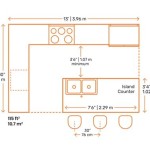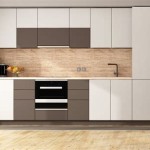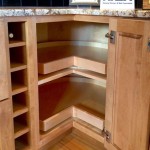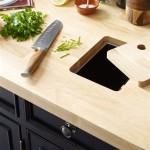7-Inch Deep Kitchen Sinks: A Comprehensive Overview
The kitchen sink, often an overlooked element, plays a pivotal role in everyday culinary tasks. Its size, material, and configuration significantly impact functionality and efficiency. Among the various depth options available, the 7-inch deep kitchen sink presents a practical balance between capacity and space-saving design. This article provides a detailed examination of 7-inch deep kitchen sinks, exploring their benefits, drawbacks, types, materials, and considerations for selecting the optimal model for a given kitchen environment.
Understanding Sink Depth and Its Implications
The depth of a kitchen sink is measured from the top edge of the basin to the bottom. A deeper sink allows for easier washing of large pots and pans, minimizing splashing and containing water more effectively. Conversely, a shallower sink may require less reaching and bending, potentially reducing strain on the back. The choice of sink depth is therefore a compromise between these factors, dependent on individual needs and preferences in relation to kitchen usage.
While deeper sinks, such as those exceeding 9 or 10 inches, provide ample space for handling larger items, they can also lead to ergonomic challenges for some users. The increased reach required to access the bottom of the sink can be uncomfortable and contribute to back pain, especially for individuals of shorter stature. Furthermore, very deep sinks can encroach on cabinet space beneath the countertop, potentially requiring modifications to plumbing or storage arrangements.
A 7-inch deep sink offers a middle ground. It provides sufficient depth to accommodate most standard dishwashing tasks without demanding excessive reaching. This depth is generally considered comfortable for a wide range of users and typically does not pose significant installation challenges in standard kitchen cabinets. It strikes a balance between functionality and ergonomic considerations, making it a popular choice for many homeowners.
Advantages of 7-Inch Deep Kitchen Sinks
The 7-inch deep kitchen sink presents several compelling advantages that contribute to its widespread appeal. These benefits stem from its optimized dimensions and balance of practicality and comfort.
First, the ergonomic benefits are substantial. The reduced reach compared to deeper sinks minimizes strain on the back and shoulders, making daily dishwashing tasks more comfortable, especially for those who spend considerable time at the sink. This is a significant consideration for individuals with pre-existing back problems or those prone to musculoskeletal discomfort.
Second, the 7-inch depth generally offers adequate capacity for most household needs. It can easily accommodate standard-sized pots, pans, plates, and utensils. While it may not be ideal for extremely large items, such as oversized roasting pans or stockpots, it is sufficient for the majority of daily dishwashing tasks in a typical household. The potential need for occasional handwashing of very large items is often outweighed by the ergonomic benefits and space-saving nature of this depth.
Third, installation is typically straightforward. The 7-inch depth rarely necessitates significant modifications to existing kitchen cabinets or plumbing. This makes it a viable option for both new installations and replacements. Standard cabinet configurations are generally designed to accommodate sinks of this depth, simplifying the installation process and minimizing associated costs.
Fourth, the reduced volume translates to potentially lower water consumption when filling the sink. While the difference in water usage may seem minimal on a per-use basis, it can accumulate over time, contributing to water conservation and potentially lowering water bills. This aspect aligns with growing environmental awareness and the desire to reduce household resource consumption.
Finally, a 7-inch depth can often be found in a wider variety of sink styles and materials due to its standard dimension. This allows homeowners greater flexibility in selecting a sink that complements their kitchen's aesthetic and suits their functional needs. From stainless steel to composite materials, the 7-inch depth is a widely manufactured size, increasing the availability of different design choices.
Potential Drawbacks and Considerations
While 7-inch deep kitchen sinks offer numerous advantages, it is important to consider potential drawbacks and limitations to ensure they align with specific needs and preferences.
One limitation lies in the reduced capacity compared to deeper sinks. While sufficient for most daily tasks, handling exceptionally large pots, pans, or baking sheets may require maneuvering or washing them in smaller sections. This may be inconvenient for individuals who frequently cook or bake in large quantities and rely heavily on the sink for cleanup.
Another consideration involves the potential for increased splashing, particularly when using a high-pressure faucet. The shallower depth may not contain water as effectively as a deeper sink, leading to more splashing onto the countertop and surrounding areas. This can be mitigated by carefully adjusting the faucet's water pressure and using accessories such as sink grids or spray wands to direct the water flow.
Furthermore, the aesthetic impact should be considered. A shallower sink may appear less visually striking than a deeper, more imposing model. This is a subjective consideration, and some homeowners may prefer the cleaner, less obtrusive look of a 7-inch deep sink, while others may prefer the bolder statement of a deeper option. The overall design and style of the kitchen should be taken into account when making this decision.
Finally, the specific design of the sink basin can influence its overall effectiveness. A sink with a flat bottom may not drain as efficiently as one with a sloped bottom, potentially leading to water pooling and food residue buildup. Similarly, the location of the drain can affect the usable space within the sink. Carefully evaluating the basin design is crucial to maximizing the functionality of a 7-inch deep sink.
Materials Commonly Used in 7-Inch Deep Kitchen Sinks
The material of a kitchen sink significantly affects its durability, aesthetic appeal, and ease of maintenance. A wide range of materials is used in the construction of 7-inch deep kitchen sinks, each with its own set of advantages and disadvantages.
Stainless steel is a popular choice due to its durability, resistance to stains and corrosion, and relatively affordable price. Stainless steel sinks are available in various gauges, with lower gauges indicating thicker, more durable steel. A gauge of 16 or 18 is generally recommended for kitchen sinks to ensure longevity and resistance to denting. Stainless steel is also relatively easy to clean and maintain, though it can be prone to water spots and scratches.
Granite composite sinks, made from a blend of granite stone dust and resin, offer exceptional durability and resistance to heat, scratches, and stains. They are available in a variety of colors and textures, allowing for greater aesthetic flexibility. Granite composite sinks are typically more expensive than stainless steel but offer a more premium look and feel. They can also be somewhat more difficult to clean, requiring specialized cleaning products to prevent staining.
Cast iron sinks, coated with a layer of porcelain enamel, are known for their durability and heat retention. They offer a classic, traditional look and are available in a range of colors. However, cast iron sinks are extremely heavy and require sturdy support during installation. The porcelain enamel can also be prone to chipping or scratching, particularly with heavy use. Repairing chips in the enamel can be challenging and costly.
Fireclay sinks, made from a dense ceramic clay fired at high temperatures, are exceptionally durable and resistant to scratches and stains. They offer a smooth, glossy surface and are available in a variety of styles, including farmhouse sinks. Fireclay sinks are typically more expensive than stainless steel and granite composite options. They are also quite heavy and require careful installation.
Copper sinks offer a unique, rustic aesthetic and possess natural antibacterial properties. They are often handcrafted and can develop a patina over time, adding to their character. Copper sinks are typically more expensive than other materials and require specialized cleaning products to maintain their appearance. They can also be susceptible to denting and scratching.
The choice of material ultimately depends on individual preferences, budget constraints, and the overall design of the kitchen. Each material offers a unique combination of durability, aesthetic appeal, and maintenance requirements.
Factors to Consider When Choosing a 7-Inch Deep Kitchen Sink
Selecting the right 7-inch deep kitchen sink involves careful consideration of several factors to ensure it meets specific needs and preferences. These factors encompass size, configuration, material, style, and budget.
First, the size of the sink should be proportionate to the available countertop space and the size of the kitchen. A larger sink may be desirable for handling larger items or for use in a busy household, while a smaller sink may be more appropriate for a compact kitchen or a single-person dwelling. The dimensions of the sink should be carefully measured to ensure it fits properly within the designated space.
Second, the configuration of the sink should be considered. Single-bowl sinks offer a large, unobstructed basin for washing large items, while double-bowl sinks provide separate compartments for washing and rinsing or for performing different tasks simultaneously. Undermount sinks are installed beneath the countertop, creating a seamless look, while drop-in sinks are installed from above the countertop. The choice of configuration depends on individual preferences and the intended use of the sink.
Third, the material of the sink should be selected based on durability, aesthetic appeal, and maintenance requirements. Stainless steel, granite composite, cast iron, fireclay, and copper are all viable options, each with its own set of advantages and disadvantages. The material should be resistant to stains, scratches, and heat, and it should be easy to clean and maintain.
Fourth, the style of the sink should complement the overall design of the kitchen. Modern kitchens may benefit from sleek, minimalist stainless steel sinks, while traditional kitchens may be better suited to cast iron or fireclay sinks. The sink should seamlessly integrate into the kitchen's aesthetic and enhance its overall appeal.
Fifth, the budget should be carefully considered. Kitchen sinks range in price from relatively inexpensive stainless steel models to more expensive granite composite, cast iron, or copper options. It is important to establish a budget and select a sink that offers the best value for the price.
Finally, the accessories should be considered. Sink grids, cutting boards, colanders, and drain strainers can enhance the functionality of the sink and make dishwashing tasks more efficient. These accessories should be compatible with the sink's dimensions and material.
By carefully considering these factors, homeowners can select a 7-inch deep kitchen sink that meets their specific needs and preferences and enhances the functionality and aesthetic appeal of their kitchen.

Single Stainless Steel 7 Inch Ss Kitchen Sink At 890 Piece In Morbi Id 19820937355

Supply 7 Inch Deep Undermount Kitchen Sink Wholesale Factory Rubysteel Industry M Sdn Bhd

7 Deep Undermount Kitchen Sink Ships Same Day Allora Usa

Kitchen Sinks 7 Inch Deep Kralsu Sink And Faucet Supplies

2 Bowl 0 8mm Stainless Steel Kitchen Sink 7 Inch Depth Made In Com

2 Bowl 0 8mm Stainless Steel Kitchen Sink 7 Inch Depth

Kitchen Sinks 7 Inch Deep Kralsu Sink And Faucet Supplies

7 Inch Stainless Steel Kitchen Sink At 6000 Piece Mumbai Id 2855366404762

Supply 7 Inch Deep Undermount Kitchen Sink Wholesale Factory Rubysteel Industry M Sdn Bhd

7 Inch Deep Kitchen Sink And Faucet Supplies Kralsu Com








